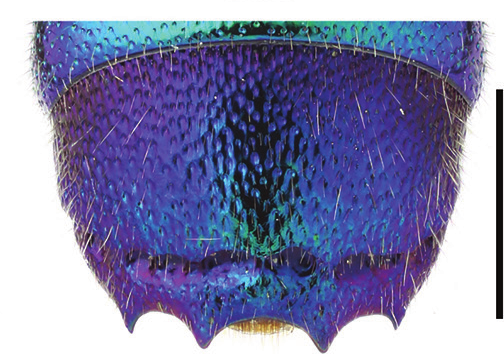Chrysis iris
- Innhold
- Diagnosis
- Distribution
- Biology
Diagnosis
Figure 83
T3, dorsal view: C. iris ♂. Scale 1 mm.
Length 7–13 mm.
The body is mostly blue or blue-green, resembling C. indigotea in colouration. The female often has green-golden reflections on the mesoscutum, mesoscutellum and anteriorly on the pronotum. The tergites are posteriorly lighter blue than anteriorly. Compared to C. indigotea, the punctation of the mesoscutum is sparser and the interstices larger, the mesoscutum is medially not distinctly darker than laterally, and the ovipositor is narrower (as in Fig. 92). The black spots of S2 are also larger and the apical teeth of T3 shorter and blunter.
Distribution
Denmark, Estonia, Finland, Latvia, Lithuania, Sweden. Relatively rare.
West Palearctic: Europe (Linsenmaier 1997).
Be aware that the records present in the GBIF map may be misleading for some countries due to unrevised data sets or missing information.
GBIF Taxon: Chrysis iris Christ, 1791Biology
Habitat: forest margins, clearings and gardens with sun-exposed dead wood. Adults are usually found on walls of old log buildings (barns, sheds etc.), log piles, poles and dead tree trunks (e.g. Populus, Salix, Betula).
Flight period: late May to late August.
Host: Symmorphus allobrogus (Saussure), S. crassicornis (Panzer) and S. murarius (Linnaeus) (Vespidae) (Abeille de Perrin 1878, du Buysson 1895, Pärn et al. 2014, our own obs.).
